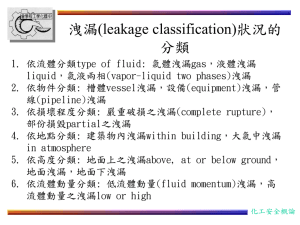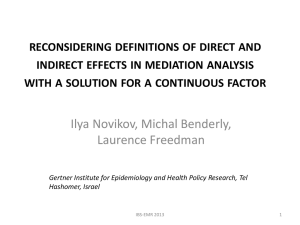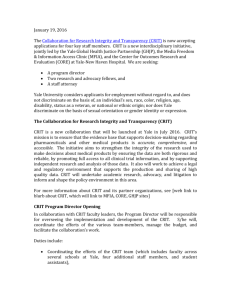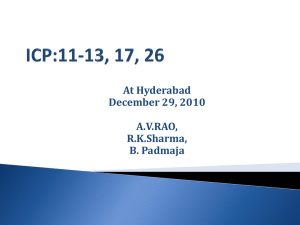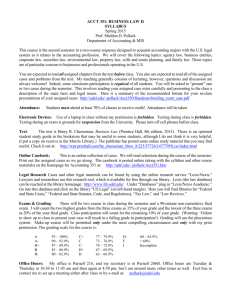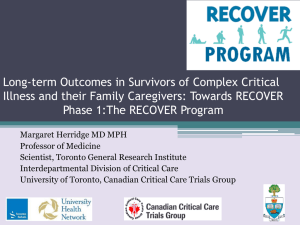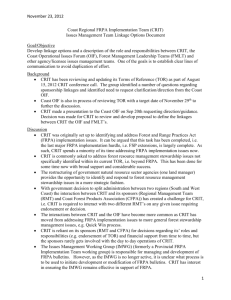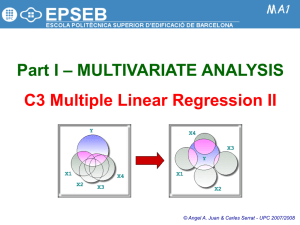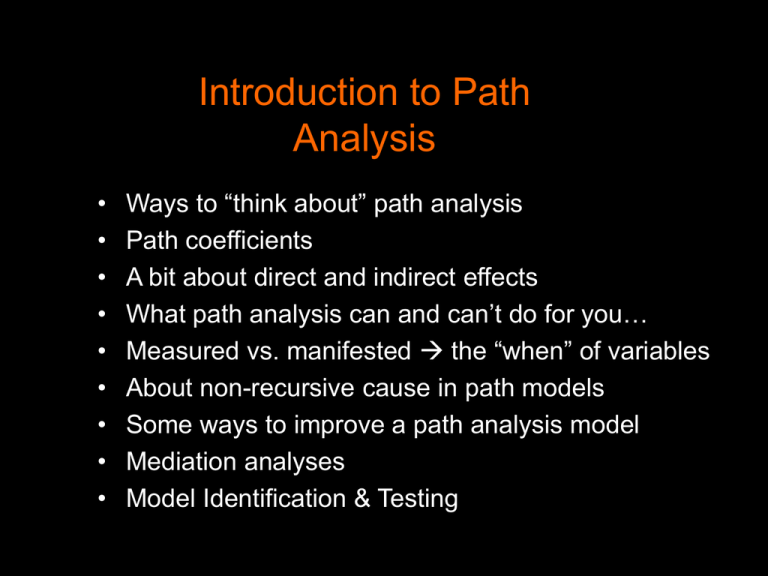
Introduction to Path
Analysis
•
•
•
•
•
•
•
•
•
Ways to “think about” path analysis
Path coefficients
A bit about direct and indirect effects
What path analysis can and can’t do for you…
Measured vs. manifested the “when” of variables
About non-recursive cause in path models
Some ways to improve a path analysis model
Mediation analyses
Model Identification & Testing
One way to “think about” path analysis is as a way of “sorting out”
the colinearity patterns amongst the predictors – asking yourself
what may be the “structure” -- temporal &/or causal relationships
-- among these predictors that produces the pattern of colinearity.
“Structure” of a MR model – with
hypotheses about which predictors
will contribute
A proposed structure for the colinearity
among the predictors and how they
relate to the criterion – with hypotheses
about which paths will contribute
1
2
3
3
Crit
5
1
4
Crit
4
2
5
earlier
More recent
distal cause
proximal cause
Where do the path coefficients come from?
One way is to run a series of multiple regressions…
for each analysis: a variable with arrows pointing at it will be the
criterion variable and each of the variables having arrows
pointing to it will be the predictors
3
1. Crit = 3 Pred = 5
2. Crit = 1 Preds = 3 & 5
5
1
4
Crit
2
3. Crit = 4 Pred = 5
4. Crit = Crit Preds = 1, 2, 3 & 4
The path coefficients are the β weights from the respective
regression analyses (remember that β = r for bivariate models)
What path analysis can and can’t accomplish…
Cans
-- for a given structural model you can…
• evaluate the contribution of any path or combination of paths to
the overall fit of that structural model
• help identify sources of suppressor effects (indirect paths)
Can’ts
• non-recursive (bi-directional) models
• help decide among alternative structural models
• provide tests of causality (unless experimental data)
So… You have to convince yourself and your audience of the
“reasonableness” of your structural model (the placing of the
predictors), and then you can test hypotheses about which
arrows amongst the variables have unique contributions.
Alternative ways to “think about” path analysis…
• to capture the “causal paths” among the predictors and to the
criterion
• to capture the “temporal paths” among the predictors and to
the criterion
• to distinguish “direct” and “indirect” paths of relationship
• to investigate “mediation effects”
… to distinguish “direct” and “indirect” paths of relationship…
3
5
2 has a direct effect on Crit
1
4
Crit
• a “contributor” in both the regression
and the path models
2
5 does not have a direct effect on
Crit – but does have multiple
indirect effects
• not “contributing” in the regression
model could mistakenly lead us to
conclude “5 doesn’t matter in
understanding Crit”
3
5
1
4
2
Crit
…to distinguish “direct” and “indirect” paths of relationship…, cont.
3
3 has a direct effect on Crit
5
1
4
Crit
2
3 also has an indirect effect
on Crit
• there’s more to the 3 Crit
relationship than was captured in
the regression model
3
5
1
4
2
Crit
… to investigate “mediation effects”…
Mediation effects and analyses highlight the difference between
bivariate and multivariate relationships between a variable and a
criterion (collinearity & suppressor effects).
For example…
For Teaching Quality & Exam Performance r = .30, p = .01
• for binary regression β = r,
so we have the path model…
TQ
β=.3
EP
It occurs to one of the researchers that there just might be something else
besides Teaching Quality related to (influencing, even) Exam Performance.
• The researcher decides that Study Time (ST) might be such a variable.
• Thinking temporally/causally, the researcher considers that Study Time
“comes in between” Teaching and Testing.
• So the researcher builds a mediation model, getting the weights from a
multiple regression with TQ and ST as predictors of EP
… to investigate “mediation effects”…
The resulting model looks like …
β=.0
TQ
EP
β=.3
ST
β=.4
We might describe model as, “The apparent effect of Teaching Quality on Exam
Performance (r=.30) is mediated by Study Time.”
We might describe the combination of the bivariate analysis and the multiple
regression from which the path coefficients were obtained as, “While Teaching
Quality has a bivariate relationship with Exam Performance (r=.30), it does not
contribute to a multiple regression model (β=.0) that also includes Study Time
(β=.40).
Either analysis reminds us that the bivariate contribution of a given predictor
might not “hold up” when we look at that relationship within a multivariate
model!
Notice that TQ is “still important” because it seems to have something to do
with study time – an indirect effect upon Exam Performance.
The “when” of variables and their place in the model …
When a variable is “measured” when we collect the data:
• usually concurrent
• often postdictive (can be a problem – memory biases, etc.)
• sometimes predictive (hypothetical – can really be a problem)
When a variable is “manifested” when the value of the
variable came into being
• when it “comes into being for that participant”
• may or may not be before the measure was taken
E.g., State vs. Trait anxiety
• trait anxiety is intended to be “characterological,” “long term”
and “context free” earlier in model
• state anxiety is intended to be “short term” & “contextual”
depends when it was measured
Some caveats about the “when” of Path & Mediation Analyses…
1. The “Causal Ordering” must be theoretically supported path
analysis can’t “sort out” alternative arrangements -- it can only
decide what paths of a specific arrangement can be dropped
2. Mediating variables must come after what they are mediating
E.g. The Treatment is related to the criterion.
rCrit,Tx = .4
But the researcher thinks that one’s gender mediates how the
treatment has its effect…
So we run a mediation analysis:
Looks like a participant’s sex
mediates the treatment.
β=.0
Tx
Crit
But it also looks like treatment
causes a participant’s sex ???
β=.3
Sex
β=.4
An example “when” and “operational definition” matter!!!
Bivariate & Multivariate contributions – DV = Exam 1% grade
predictor
r(p)
Motiv
.28(<.01)
St. Time
.45 (<.01)
GPA
.46 (<.01)
% Pink
.33(<.01)
All of these predictors have substantial correlations with Exam grades!!
β(p)
.32(.02)
-.25(.04)
.09(.51)
.58 (.01)
GPA does not have a significant regression weights – after taking the other
variables into account, it has no unique contribution!
Exam study time has a significant regression weight, however, notice that it is
part of a suppressor effect! After taking the other variables into account,
those who study more for the test actually tend to do poorer on the exam.
%Pink does have a significant regression weight. Even after taking the other
variables into account, those who do more MTAs do better on the exam.
Motivation does have a significant regression weight. After taking the other
variables into account, those who are more motivated do better on the exam.
Notice that only two of the 4 predictors had the same “story” from
the bivariate and multivariate analysis!!!!
Path Analysis – allows us to look at how multiple predictors relate
to the criterion – considering both “direct” and “indirect” relationships!!
Motiv
.33
%Pink
GPA
St Time
-.31
.32
.58
-.25
Exam 1%
Direct effects
(same as MReg βs)
Indirect
effects
.21
GPA no direct effect – but indirect effects thru %pink & St Time
Motiv direct effect – also indirect effects thru %pink & St Time
%Pink direct effect – also indirect effect thru St Time
-β for St Time? Less %Pink predicts more St Time, suggesting that
those who study more were those who did less work before they
started to study for the exam, and they also did poorer on the exam!
About non-recursive (bi-directional) models
1
Sometimes we want to consider
whether two things that “happen
sequentially” might have “iterative
causation” – so we want to put in
a back-and-forth arrow
Sometimes we want to consider
whether two things that “happen
at the same time” might have
“reciprocal causation” – so we
want to put in a sideways arrow
3
Crit
5
4
2
1
3
Crit
5
4
2
Neither of these can be “handled” by path analysis.
However, this isn’t really a problem because both are a
misrepresentation of the involved causal paths! The real way
to represent both of these is …
The things to remember are that:
1. “cause takes time” or “cause is not immediate”
• even the fastest chemical reactions take time
• behavioral causes take an appreciable amount of time
2. Something must “be” to “cause something else to be”
• a variable has to be manifested as an effect of some
cause before it can itself be the cause of another effect
• Cause comes before effect not at the same time
When you put these ideas together, then both “sideways” and
“back-and-forth” arrows don’t make sense and are not an
appropriate portrayal of the causations being represented.
The causal path has to take these two ideas into account…
About non-recursive (bi-directional) models
1
If “5” causes “4”, then “4” changes
“5”, which changes “4” again, all
before the criterion is caused, we
need to represent that we have 2
“4s” and 2 “5s” in a hypothesized
sequence.
5
4
We also have to
decide when1, 2 & 3
enter into the model,
temporally &/or
causally. Say …
5
3
Crit
5
4
2
4
Crit
1
3
5
4
5
4
2
Crit
About non-recursive (bi-directional) models, cont…
1
When applying these ideas to
“sideways arrows” we need to
remember that the cause comes
before the effect.
3
Crit
5
4
2
To do that, we have to decide (& defend) which comes first – often
the hardest part) and then add in the second causation, etc.… As
well as sort out where the other variables fall temporally &/or
causally. Perhaps …
1
4
1
3
Crit
5
2
Some of the ways to improve a path analysis
TQ
For a given model,
consider these 4 things….
EP
ST
1. Antecedents to the current model
• Variables that “come before” or “cause” the variables in
the model
2. Effects of the current model
• Variables that “come after” or “are caused by” the variables
in the model
3. Intermediate causes
• Variables that “come in between” the current causes and
effects.
4. Non-linear variations of the model
• Curvilinear & interaction effects of & among the variables
Mediation Analyses
The basic mediation analysis is a 3-variable path analysis.
A correlation shows that “var” is related to the “crit” .
But we wonder if we have the
“whole story” – is it really that
variable that causes Crit ???
Var
Crit
Med
So, we run a regression analysis w/ Var & Med as preds of Crit.
Then we compare two estimates of the Var – Crit relationship
• rCrit,Var from the bivarate model &
• βVar from the multivariate model
If βVar = .00 complete mediation
If .00 < βVar < rCrit,Var partial mediation
If βVar = rCrit,Var no mediation
The Sobol test is used to evaluate the rCrit,Var - βVar difference
Model “Identification” & Testing
Just-identified model
• number of path coefficients to be estimated equals the
number of independent correlations (k*(k-1)) / 2
• “full model” with all recursive paths
Over-identified model
• more correlations than path coefficients
• because one or more path coefficients are set to zero
Under-identified model
• more math coefficients to be estimated than independent
correlations
• “can’t be uniquely estimated”
• full model with nonrecursive paths
Testing Causal Models
Theory Trimming
• fancy phrase for “deleting non-contributing paths”
• identify paths with nonsignificant contributions (non significant
β in the relevant regression model) and call them “zero”
Concerns & Challenges
• usual problems of post-hoc procedures – must support model…
• based on literature review
•“test” model on a new sample
• problem is compounded in path analysis (relative to a single
regression model) because testing of contributions within a
single regression is not a test of the contribution of that path to
the model
• it is possible to find that deleting one or variables that do not
contribute to a particular multiple regression does degrade
the fit of the path model to the data
Testing Over-identified models
When we hypothesize that certain path coefficients are zero (that
certain direct effects don’t contribute to the model) the resulting
model is over-identified and can be compared to the fit of …
• the related just-identified (full) model
• other related over-identified models in which it is “nested”
It is really important to remember that you can not deduce that
one path model (the arrangement of “layers” and “variables”) is
better than another from these tests!! These tests only examine
the contribution of specific variables within a specific model to
that model, they do not test “the model”
• By analogy …
• we know we can’t talk about which multiple regression model is
better based on which one has the bigger R2 change when we
drop a particular predictor from each
• we can’t say which path model is better based on which one
changes most when certain paths are set to zero
Testing Over-identified models
Testing H0: “The Reduced model fits the data as well as the
Full model”
1. Calculate the variance accounted for by the full model
R2full = 1 – Π(1-R2Fi) = 1 – (1-R2F1)*(1-R2F2)*(1-R2F3)…
where R2Fi is the R2 from each regression used to get the coefficients
of the full model (all with all predictors included)
2. Calculate the variance accounted for by the reduced model
R2reduced = 1 – Π(1-R2Ri) = 1 – (1-R2R1)*(1-R2R2)*(1-R2R3)…
where R2Ri is the R2 from each regression used to get the coefficients of
the reduced model (at least one of which has had one or more
predictors excluded; i.e., that predictor’s path set to .00)
Testing Over-identified models
3. Calculate W – the summary statistic of model-fit difference
W = -(N – d) loge
4.
1 - R2full
-----------------1 - R2reduced
N = sample size
d = # deleted paths
Obtained the Wcrit value
Wcrit = X2crit for df = d
5. Test the H0:
If W > Wcrit, reject H0: that Full = Reduced and conclude
• the full model fits the data better than the Reduced model
• one or more of the deleted paths contributes to the model
If W < Wcrit, retain H0: that Full = Reduced and conclude
• the Reduced model fits the data as well as the Full model
• the deleted paths did not contribute to the model

